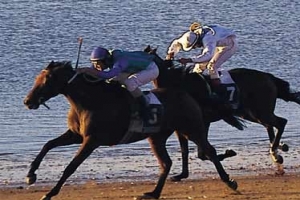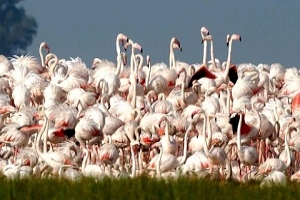Tours to Islamic Spain

|

|
|
www.islamiccity.com By the time 'Abd al-Rahman reached Spain, the Arabs from North Africa
were already entrenched on the Iberian Peninsula and had begun to write one of the most glorious chapters in Islamic history.
After their forays into France were blunted by Charles Martel, the Muslims in Spain had begun to focus their whole attention on what they called al-Andalus, southern Spain (Andalusia), and to build there a civilization far superior to anything Spain had ever known. Reigning with wisdom and justice, they treated Christians and Jews with tolerance, with the result that many embraced Islam. They also improved trade and agriculture, patronized the arts, made valuable contributions to science, and established Cordoba as the most sophisticated city in Europe.
By the tenth century, Cordoba could boast of a population of some 500,000, compared to about 38,000 in Paris. According to the chronicles of the day, the city had 700 mosques, some 60,000 palaces, and 70 libraries - one reportedly housing 500,000 manuscripts and employing a staff of researchers, illuminators, and book binders. Cordoba also had some 900 public baths, Europe's first street lights and, five miles outside the city, the caliphal residence, Madinat al-Zahra. A complex of marble, stucco, ivory, and onyx, Madinat al-Zahra took forty years to build, cost close to one-third of Cordoba's revenue, and was, until destroyed in the eleventh century, one of the wonders of the age. Its restoration, begun in the early years of this century, is still under way.
By the eleventh century, however, a small pocket of Christian resistance had begun to grow, and under Alfonso VI Christian forces retook Toledo. It was the beginning of the period the Christians called the Reconquest, and it underlined a serious problem that marred this refined, graceful, and charming era: the inability of the numerous rulers of Islamic Spain to maintain their unity. This so weakened them that when the various Christian kingdoms began to pose a serious threat, the Muslim rulers in Spain had to ask the Almoravids, a North African Berber dynasty, to come to their aid. The Almoravids came and crushed the Christian uprising, but eventually seized control themselves. In 1147, the Almoravids were in turn defeated by another coalition of Berber tribes, the Almohads.
Although such internal conflict was by no means uncommon- the Christian kingdoms also warred incessantly among themselves- it did divert Muslim strength at a time when the Christians were beginning to negotiate strong alliances, form powerful armies, and launch the campaigns that would later bring an end to Arab rule.
The Arabs did not surrender easily; al-Andalus was their land too. But, bit by bit, they had to retreat, first from northern Spain, then from central Spain. By the thirteenth century their once extensive domains were reduced to a few scattered kingdoms deep in the mountains of Andalusia - where, for some two hundred years longer, they would not only survive but flourish.
It is both odd and poignant that it was then, in the last two centuries of their rule, that the Arabs created that extravagantly lovely kingdom for which they are most famous: Granada. It seems as if, in their slow retreat to the south, they suddenly realized that they were, as Washington Irving wrote, a people without a country, and set about building a memorial: the Alhambra, the citadel above Granada that one writer has called "the glory and the wonder of the civilized world."
The Alhambra was begun in 1238 by Muhammad ibn al-Ahmar who, to buy safety for his people when King Ferdinand of Aragon laid siege to Granada, once rode to Ferdinand's tent and humbly offered to become the king's vassal in return for peace.
It was a necessary move, but also difficult - particularly when Ferdinand called on him to implement the agreement by providing troops to help the Christians against Muslims in the siege of Seville in 1248. True to his pledge, Ibn al-Ahmar complied and Seville fell to the Christians. But returning to Granada, where cheering crowds hailed him as a victor, he disclosed his turmoil in that short, sad reply that he inscribed over and over on the walls of the Alhambra: "There is no victor but God."
Over the years, what started as a fortress slowly evolved under Ibn al-Ahmar's successors into a remarkable series of delicately lovely buildings, quiet courtyards, limpid pools, and hidden gardens. Later, after Ibn al-Ahmar's death, Granada itself was rebuilt and became, as one Arab visitor wrote, "as a silver vase filled with emeralds."
Meanwhile, outside Granada, the Christian kings waited. In relentless succession they had retaken Toledo, Cordoba, and Seville. Only Granada survived. Then, in 1482, in a trivial quarrel, the Muslim kingdom split into two hostile factions and, simultaneously, two strong Christian sovereigns, Ferdinand and Isabella, married and merged their kingdoms. As a result, Granada fell ten years later. On January 2, 1492 - the year they sent Columbus to America - Ferdinand and Isabella hoisted the banner of Christian Spain above the Alhambra and Boabdil, the last Muslim king, rode weeping into exile with the bitter envoi from his aged mother, "Weep like a woman for the city you would not defend like a man!"
In describing the fate of Islam in Spain, Irving suggested that the Muslims were then swiftly and thoroughly wiped out. Never, he wrote, was the annihilation of a people more complete. In fact, by emigration to North Africa and elsewhere, many Muslims carried remnants of the Spanish era with them and were thus able to make important contributions to the material and cultural life of their adopted lands.
Much of the emigration, however, came later. At first, most Muslims simply stayed in Spain; cut off from their original roots by time and distance they quite simply had no other place to go. Until the Inquisition, furthermore, conditions in Spain were not intolerable. The Christians permitted Muslims to work, serve in the army, own land, and even practice their religion - all concessions to the importance of Muslims in Spain's still prosperous economy. But then, in the period of the Inquisition, all the rights of the Muslims were withdrawn, their lives became difficult, and more began to emigrate. Finally, in the early seventeenth century, most of the survivors were forcibly expelled.
Cordoba tour
The Great Masjid of Cordoba is one of the most important monuments in the world, and one of the few remaining structures from the Muslim era still extant in Spain. We will visit the Mezquita (as it is called in Spanish), which was consecrated as a church in the 13th century when Cordoba was conquered by Spanish Christians from the north. In the 16th century, a Renaissance cathedral was built into the center of the masjid, by the order of Emperor Charles V, who later regretted his decision with the words: "You have destroyed something unique in the world with something that can be found anywhere."
The Umayyad palace known as the Alcazar, situated next to the masjid, is also worth visiting, with its structures and gardens. As we visit these sites, we will discuss the building techniques and history of the structures.
We will also visit the Jewish quarter, located close to the Mezquita, and one the synagogues that has survived over the centuries.
Grenada tour
We will spend several days in this important city. During our first day, we will walk along the streets of the new city, familiarizing ourselves with the layout and observing various Islamic monuments, including a funduq (caravansery) where merchants used to rest and store their goods. We will also visit the extant hammam (Arab bath) which was constructed in the 12th century under the Zirid rulers. We will spend the evening in the old city of Granada, known as the albaicin, where the modern Muslim community makes its home. There are many Muslim restaurants and tea shops in this neighborhood.
The following day we will visit the Alhambra palace complex, as well as the summer retreat of the Granadan kings, known as the Generalife (from jannat al-arif, "garden of the architects"). The Alhambra is named for the reddish color of its walls, and was called al-hamra' in Arabic.
There is a free day scheduled in Granada for those who would like to revisit the Alhambra or spend more time in the Albaicin, or simply explore further.
We will also walk across the Roman bridge which traverses the Guadalquivir and discuss the agricultural technology and methods used by Andalusi Muslims.
|
| Back to main page
|
|
|
|
|
|
|

Countdown to World Tourism Day 2012 .. ..
With less than one week to go to World Tourism Day (WTD) on September 27, preparations for the official celebrations in host country Spain are well underway.
(23/09/2012)
|
|

Horse races on the beach
Since 1845, during the evening\'s low tide in the month of August, the beaches of Sanlúcar de Barrameda have been used for horse races. Popular tradition has it that the origins of these celebr (16/08/2012)
|
|
|
|
|
|
|

MITM 2012 IN GRANADA, SPAIN, A PLUS
GSAR Marketing, who celebrates this year its 30th anniversary, offers a plus to exhibitors of the 16th edition of MITM Euromed, Meetings and Incentive Travel Market (08/06/2012)
|
|
|

Ecotourism in Spain
Come and discover Spain’s natural spaces in an original way, but with the utmost respect for the environment (20/03/2012)
|
|
|
|
|
Showing 19 news articles
Back
To Top

|
|
